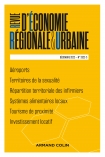
REVUE D'ÉCONOMIE RÉGIONALE ET URBAINE (2/2021)
Pour acheter ce numéro, contactez-nous
Recevez les numéros de l'année en cours et accédez à l'intégralité des articles en ligne.
La production du logement social en France des années 1930 correspond à une époque où une nouvelle génération de penseurs de la ville, les urbanistes, élaborent pour la première fois des Plans d’Aménagement d’Embellissement et d’Extension (PAEE) pour les agglomérations françaises et qui vont traverser la méditerranée. Oran, ville dont la première extension se fait pendant l’application de la loi Cornudet et de la politique des Habitations à Bon Marché (HBM), constitue un bon exemple de cette orientation. Nous présentons dans cette contribution une analyse urbanistique des travaux de réalisation du PAEE d’Oran et de l’expérience des HBM de Choupot. L’objectif ici est de vérifier l’hypothèse suivante : la première extension d’Oran s’est faite dans un contexte favorable à l’expérimentation, visant l’homogénéisation de la ville et sa continuité urbaine à travers la conception et la réalisation du logement et son prolongement de l’habitat.
The French production of public housing in the 30’s corresponds to an era when a new generation of city thinkers, the urban planners, elaborates improvement and expansion plans in French cities that will go through the Mediterranean Sea. Considered as revolutionary in France, their concepts will be better received on the southern shores of the Mediterranean, especially in Oran where a new world is under construction. The 1st expansion of Oran is made during the application of the Cornudet law and the low-cost housing policy (LCH), and represents a good example of this concept realisation. Indeed, this experience remains nonetheless special by its sequence during an economic and political climate favourable of innovation, but also thanks to the fruitful collaboration of its builders. This is why, among other things, this experience is exceptional, and we endeavour to analyse it in order to grasp the complexity of the relationships gathering decision-makers, project managers, executers and citizens. This article is an urbanistic analysis of the Expansion and Embellishment Planning of Oran execution works and the LCH of Choupot case study. The objective is to verify the following hypothesis: the 1st enlargement of Oran was made in a context favourable to experimentation, aiming to homogenize the city and its urban continuity through the design and realisation of housing settlements. Since, the production methods of the urban fabric through LCH have been radically different from those of the high-rise residential complexes generating conversely an urban rupture, due to the large scale of housing agglomerations. The LCH shape autonomous and small-scale urban complexes integrating into the surrounding urban fabric and where the diversity of activities brings life to these urban spaces.

